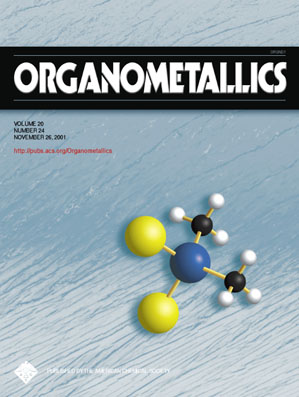







|
|
|
Journal
Publications |
|
Synthesis of a New Class
1,4-Bis(diphenylphosphino)-1,3-butadiene
Bridged Diphosphine, NUPHOS, via Zirconium Mediated Reductive Coupling
of Alkynes and Diynes: Application in Palladium Catalyzed Cross Coupling
and Suzuki Coupling Reactions.
Simon Doherty, Edward G. Robins, Mark Nieuwenhuyzen, Julian G. Knight, Paul A. Champkin and William Clegg,
Organometallics, 2002, 21, 1383. |
|
Abstract: Zirconium-mediated inter- and
intramolecular reductive cyclization of alkynes and diynes has been used
to prepare a new class of bidentate phosphine, based on a four-carbon sp2-hybridized
tether. Intermolecular coupling of diphenylacetylene and but-2-yne with
Negishi's reagent followed by transmetalation with copper chloride prior
to quenching with chlorodiphenylphosphine affords the corresponding
acyclic diphosphines
1,4-bis(diphenylphosphino)-1,2,3,4-tetraphenyl-1,3-butadiene (2a;
1,2,3,4-Ph4-NUPHOS) and
1,4-bis(diphenylphosphino)-1,2,3,4-tetramethyl-1,3-butadiene (2b;
1,2,3,4-Me4-NUPHOS), respectively. A single-crystal X-ray
analysis of the former has been obtained. Surprisingly, 1-phenylpropyne
undergoes a highly regioselective reductive cyclization to afford
1,4-bis(diphenylphosphino)-1,3-diphenyl-2,4-dimethyl-1,3-butadiene (2c;
1,3-Ph2-2,4-Me2-NUPHOS). Similarly,
transmetalation of the zirconacyclopentadiene generated from
3,9-dodecadiyne and 1,8-diphenyloctadiyne followed by electrophilic
liberation of the resulting copper diene reagent with
chlorodiphenylphosphine gave
1,2-bis(1-(diphenylphosphino)prop-1-ylidene)cyclohexane (2d;
1,4-Et2-2,3-cyclo-C6H8-NUPHOS) and
1,2-bis(1-(diphenylphosphino)benzylidene)cyclohexane (2e; 1,4-Ph2-2,3-cyclo-C6H8-NUPHOS),
respectively. This methodology provides a convenient and versatile
one-pot synthesis of a wide range of 1,3-diene bridged diphosphines.
Single-crystal X-ray analyses of [(1,2,3,4-Ph4-NUPHOS)PdCl2],
[(1,3-Ph2-2,4-Me2-NUPHOS)PdCl2], and
[(1,4-Ph2-2,3-cyclo-C6H8-NUPHOS)PtCl2]
reveal that these new phosphines coordinate to palladium and platinum in
much the same manner as BINAP and dpbp, with a significant torsional
twist about the C(2)-C(3) bond of the backbone. The copper diphosphine
intermediate [Cu(1,4-Et2-2,3-cyclo-C6H8-NUPHOS)Cl]2
(1d) has also been isolated and characterized by single-crystal
X-ray analysis and exists as the chloro-bridged dimer in which the
1,2-bis(1-(diphenylphosphino)prop-1-ylidene)cyclohexane coordinates in a
bidentate manner. Palladium complexes of these new diphosphines are
highly active for the cross-coupling of bromobenzene and sec-butylmagnesium
bromide. Catalyst mixtures based on 1,2,3,4-Ph4-NUPHOS are
far superior to those based on BINAP, with activities of 6900 and 260
(mol of product) (mol of palladium)-1 h-1,
respectively. In fact, catalysts based on 1,2,3,4-Ph4-NUPHOS
are ~30 times more active than the most active catalyst reported to date
for this coupling. In comparison, the selectivity of the corresponding
cross-coupling with 2-bromopropene depends markedly on the nature of the
NUPHOS derivative. In general, those based on NUPHOS derivatives with
acyclic tethers, namely 2a-c, are highly selective for the
formation of 2,3-dimethylpentene, while those formed from 2d,e
gave a mixture of 2,3-dimethylpentene, 2-methylhexene, and
2,3-dimethylbutadiene. The initial TOF, measured after 20 min, also
shows a marked variation on the nature of the phosphine and while all
NUPHOS-based catalysts outperform those based on BINAP, catalyst
mixtures based on dppf showed both high selectivity (>99%) and
impressive activity. Mixtures of Pd2(dba)3 and the
NUPHOS derivatives 2a-e also catalyze the Suzuki
cross-coupling of bromobenzene and 4-bromoacetophenone with phenyl
boronic acid, with conversions up to 100% at catalyst loadings as low as
0.0001 mol % Pd (TON = 1 × 106). |
| |
|
|
|



